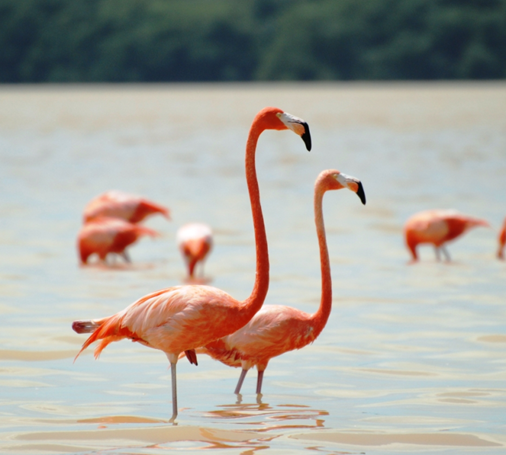The Caribbean flamingo (Phoenicopterus ruber)
 The Caribbean flamingo (Phoenicopterus ruber, Linneo 1758) is a large wading bird in te order Phoenicopteriforme, in the family Phoenicopteridae, who lives in Central America. It is a short-distance migrant. It was formerly considered the same specie as the greater flamingo (Phoenicopterus roseus).
The Caribbean flamingo (Phoenicopterus ruber, Linneo 1758) is a large wading bird in te order Phoenicopteriforme, in the family Phoenicopteridae, who lives in Central America. It is a short-distance migrant. It was formerly considered the same specie as the greater flamingo (Phoenicopterus roseus).
The Caribbean flamingo is a large bird with reddish-pink plumaje. Adult Caribbean flamingos are smaller on average tan greater flamingo. They measure from 120 to 145 cm tall. The males weigh 2.8 kg while females average 2.2. The beak is pink and white with black tip. The legs are entirely pink.
The Caribbean flamingo lay an egg between May and August. The hatching duration usually lasts about a month and both parents care for their breeding for about 6 years, at which point the flamingo reaches sexual maturity. His life expectancy is around 40 years.
According to the IUCN Red List, its current state of conservation is of Minor Concern (LC) so it does not endanger its situation, although some populations have been lost by human action after the discovery of America by the Europeans.
This bird can be found in shallow lakes, marshes and coastal waters of Cuba, Hispaniola, Bahamas, Turks and Caicos Islands, Trinidad and Tobago, coastal Venezuela, Colombia and the Yucatan Peninsula. There is also a more remote population that presents small genetic differences and lives in the Galapagos Islands. Formerly it could be found populations of flamingos in Florida, currently it is only possible to see wandering birds that come from the Cuban populations.
Its diet is based on small insects, shrimp, plants, diatoms and algae that they find when wading through shallow waters looking among the silty sediment from the bottom. It eat down its long neck and over the water, with its beak pointing upwards it is feeding. Inside the beak, the animals and plants are collected between the lamellae that form leaflets in the form of a comb, among which the water passes. The color of its plumage depends directly on its diet, which ranges from pale pink to vermilion, depending on the area where it lives and the amount of shellfish with a high content of carotenoids consumed.